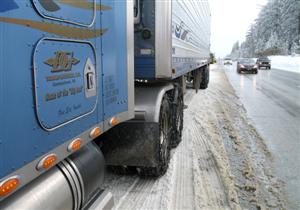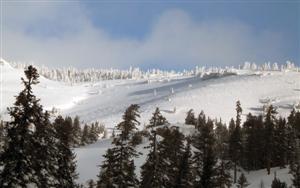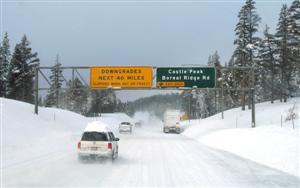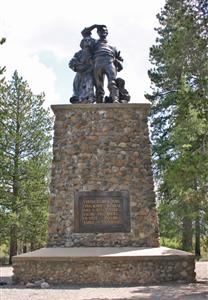SEPTEMBER 2006 TRUCKER TALK
THE LEGENDARY DONNER PASS
By Writers and Owner
Operators Rod & Kim Grimm
It’s almost time to think about carrying chains for winter, and for us, that means getting ready to climb over Donner Summit in a blizzard – yuk! Personally, I hope that the skiers have a little less snow this winter (the last one was pretty brutal). But as we complain about “throwing iron” think about what the Donner Party went through when they got stuck on the hill in 1846 with oxen and wagons and no Interstate 80. Let’s face it, we’re not that tough. But Donner Pass is more than just a snowy mountain to conquer; it’s a beautiful area that is rich with history.
I’ve talked to drivers who used to go across Donner when it was just a two lane road. They told me that two trucks couldn’t meet on a bridge without hitting mirrors. These brave drivers faced the daunting climb in trucks with a little 318 Detroit, no power steering and not much of a heater to speak of. Today, we’re spoiled with our big power engines, our more-than-adequate heat and air conditioning, Jake brakes and four lanes. And, frankly, I like it that way.
 The
story of the Donner Party is as famous as the sinking of the Titanic.
The fateful trip began in Springfield, IL in mid-April 1846 when 87 emigrants
set out to find a better life in California. Stopping in Independence,
MO on May 11, the party joined a larger wagon train. They traveled with
this group until they reached Little Sandy River (which is now Wyoming).
Once there, some of the party decided to take a new route (Hastings Cutoff,
named after its promoter Lansford Hastings) and formed a new wagon train.
This group elected George Donner as their captain, thus creating the Donner
Party on July 19th.
The
story of the Donner Party is as famous as the sinking of the Titanic.
The fateful trip began in Springfield, IL in mid-April 1846 when 87 emigrants
set out to find a better life in California. Stopping in Independence,
MO on May 11, the party joined a larger wagon train. They traveled with
this group until they reached Little Sandy River (which is now Wyoming).
Once there, some of the party decided to take a new route (Hastings Cutoff,
named after its promoter Lansford Hastings) and formed a new wagon train.
This group elected George Donner as their captain, thus creating the Donner
Party on July 19th.
The party continued westward, enduring several hardships while crossing the Wasatch Mountains and the Great Salt Lake Desert. When they finally rejoined the California Trail (near what is now Elko, NV) they had lost three weeks taking the “shortcut” (even back then a shortcut wasn’t always the best or fastest way to go). By the time they reached the Sierra Nevada, an early snow storm blocked the pass. Demoralized and low on supplies, about two thirds of the emigrants camped out at what is now called Donner Lake, while the Donner families and a few others camped at Alder Creek about six miles away.
The emigrants slaughtered their oxen, but there was not enough meat to feed so many people for so long. Around mid-December, fifteen of the trapped emigrants, later known as the Forlorn Hope, set out on snowshoes for Sutter’s Fort, about 100 miles away, to seek help. When one man gave out and had to be left behind, the others continued, but soon became lost and ran out of food. Caught without shelter in a raging blizzard, four more of the party died. The survivors resorted to cannibalism. Three more died and were eaten before finally, nearly naked and close to death, seven of the original fifteen reached safety on the western side of the mountains on January 18, 1847.
Californian’s rallied to save the Donner Party and equipped a total of four “reliefs” or rescue parties. These reliefs went into the mountains, one at a time, and brought out as many survivors as possible each trip. It took several weeks to get them all out, and these rescuers witnessed some pretty awful things up there on the mountain. The last surviving member of the party arrived at Sutter’s Fort on April 29, 1847. Of the original 87 pioneers in the Donner Party, 41 died and 46 survived. The stories of cannibalism and the tragic trip across the mountain that winter will be talked about forever.
 If
you go online and search for Donner Pass, there is a wealth of information,
such as the Donner Party Logs, which tell what happened each day, what
the weather was like, what happened to those who survived and what happened
to those who didn’t. The diaries also tell us about the Alder Creek campsite
and the lake cabins. It’s hard to imagine that when they started off on
their journey, the emigrants were looking for a better life in California.
I hope the trip was worth it and that California lived up to their expectations
after all that.
If
you go online and search for Donner Pass, there is a wealth of information,
such as the Donner Party Logs, which tell what happened each day, what
the weather was like, what happened to those who survived and what happened
to those who didn’t. The diaries also tell us about the Alder Creek campsite
and the lake cabins. It’s hard to imagine that when they started off on
their journey, the emigrants were looking for a better life in California.
I hope the trip was worth it and that California lived up to their expectations
after all that.
The Pioneer Monument is located at Donner Memorial State Park off I-80 at Donner Pass Road (on the east side of Donner Lake). The monument is a statue of a man with a young child clinging to his leg and a woman holding a baby looking westward. The statue sits atop a 22-ft. tall base of stone, which graphically illustrates how deep the snow was that fateful winter of 1846 and 1847. Next to the monument is the Emigrant Trail Museum which depicts the history of the area and the people who came into this part of the Sierra, including local Native Americans, the Donner Party, and builders of the transcontinental railroad. Also starting at the museum is a self-guided nature trail which is a half mile loop.
I’ve always loved going over Donner Pass – the scenery is spectacular. It’s so beautiful in the winter (if you’re lucky enough to be there after the snow and they’ve dropped the chain law it’s even better). This year, on Easter Sunday, we weren’t so lucky. The snow had stopped and it was beautiful, but we still had to chain up to get over in time to make our deliveries. What a photo opportunity!
Not too long ago, on another trip, we stopped at Nyack to take a nap before we went on down the hill in the morning. Our dog Bucky had a nature call at 3:30 a.m. and after I got out of the truck I couldn’t be mad at him – the smell of pine filled the air and the sky was dotted with more stars than I’d ever seen before. At the higher elevation and with no city lights to mess it up, the view was awesome! If you’ve never stopped at Nyack, you should. In the little convenience store, they have old newspaper pictures and articles on the walls, huge pinecones you can buy for souvenirs and a Burger King for a picnic across the street where there are a couple of tables. But I wouldn’t recommend sleeping there in the winter unless you don’t mind waking up with a couple feet of snow on your hood.
Just before the Nyack exit, going west on I-80, is a Vista Point that has a plaque that tells how the pioneers used to lower their oxen, wagons and supplies down the side of the mountain with ropes. And they think they have rides at amusement parks today. I think that would be like the roller coaster that goes upside down for me – NO thanks!
 Located
in the Northern sector of the Sierra-Nevada Mountains, Donner Pass’ highest
elevation (on the road) is 7,239 feet above sea level. Believe it or not,
the average snowfall at the ski areas just south of Donner Pass near Lake
Tahoe is 350-600 inches (30 to 50 feet) per year. That makes the Donner
Pass area one of the snowiest places in the United States (I can’t say
that I am too surprised).
Located
in the Northern sector of the Sierra-Nevada Mountains, Donner Pass’ highest
elevation (on the road) is 7,239 feet above sea level. Believe it or not,
the average snowfall at the ski areas just south of Donner Pass near Lake
Tahoe is 350-600 inches (30 to 50 feet) per year. That makes the Donner
Pass area one of the snowiest places in the United States (I can’t say
that I am too surprised).
Enjoy the mountain – be it spring, when the snow is melting and the rivers are raging; summer, when the skies are clear and the heat is not too unbearable; fall, when the colors get really interesting; or winter, when the beautiful white snow blankets the ground and trees (until the snowplows mess it up). If you have to chain up, be safe. When we got on the road 20 years ago, a driver told us, “You can go down a mountain a hundred times too slow, but only one time too fast.” He also advised us not to fear the mountains, but respect them (fear can get you into a lot of trouble in a hurry). Common sense will take you a long way. Wise words to live by if you drive a truck and run in the mountains – especially if you have to cross the legendary Donner Pass.
Copyright
© 2006 10-4 Magazine and Tenfourmagazine.com
PO Box 7377 Huntington Beach, CA, 92615 tel. (714) 378-9990 fax
(714) 962-8506

